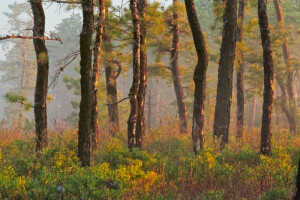 At least once a year, usually in mid-fall, I drive through part of the New Jersey Pine Barrens on my way to Atlantic City. The barrens is a magical and ecologically unique area, the subject of history and lore. It is, allegedly, home to the New Jersey devil, a beast that is reputed to be scary and is almost certainly apocryphal. The spell of the area takes hold of me, even though I only skirt its edges as I speed down the Garden State Parkway and Atlantic City Expressway.
At least once a year, usually in mid-fall, I drive through part of the New Jersey Pine Barrens on my way to Atlantic City. The barrens is a magical and ecologically unique area, the subject of history and lore. It is, allegedly, home to the New Jersey devil, a beast that is reputed to be scary and is almost certainly apocryphal. The spell of the area takes hold of me, even though I only skirt its edges as I speed down the Garden State Parkway and Atlantic City Expressway.
As you drive south along the Garden State Parkway, which is like the spine of eastern New Jersey, there is a point at which the soil on the side of the road lightens and turns sandy. The sandy soil, with its high acidity and free-draining nature, is what makes the Pine Barrens environmentally singular. Though the “barren” epithet might make you think otherwise, there are hundreds of plant species growing there. Some grow nowhere else.
The richness and uniqueness of the Pine Barrens ecosystem wasn’t officially recognized until the twentieth century, when, in 1978 an act of Congress created the Pinelands National Reserve.
Long before government took official notice of the area, Elizabeth C. White—1871-1954– scion of a prominent South Jersey cranberry farming family, and mother of New Jersey’s blueberry industry, established a native plant garden at her home, Suningive, in Whitesbog Village in Pemberton, Burlington County. In her day, she nurtured a host of indigenous plants including my favorite, the Pine Barrens gentian or Gentiana autumnalis. This plant, with its vivid blue flowers, depends not only on the Pine Barrens’ unique soil, but on lightening-sparked fires that are common in the area. Those fires create clear spaces, allowing light to get through to the plants. Development, fire suppression, and invasive, non-native plants now threaten the gentian which is also at home in the United States Botanical Garden in Washington, D.C.
I think of the little Pine Barrens gentian as I whiz by openings in the pine forest. The open spaces adjacent to roadways are one of the spots where gentians may colonize. Since I usually travel through the Pine Barrens in the fall, I hope someday to see some in bloom. The plants are small, but gentian blue is so bright that I like to believe I might be able to spot them.
Elizabeth White also grew swamp magnolia, sometimes commonly known as sweetbay magnolia, and categorized botanically as Magnolia virginiana. In Virginia, the area from which it gets its name, swamp magnolia grows as a small tree. In the Pine Barrens, it is more likely found in shrub form. True to its name, the plants love wet, acidic soil and flourish in sun or partial shade. The leaves are glossy green on top and silvery underneath, and the pristine white flowers have the lemony scent that is characteristic of magnolias. While not unique to the New Jersey Pine Barrens, swamp magnolia must have been one of the stars of Elizabeth White’s garden.
She also grew sand myrtle or Kalmia buxifolia, part of the heath and heather clan, and related to mountain laurel. The shrubs grow up to three feet tall and four feet wide, relishing the wet sandy soil. Pinkish buds open to small clusters of white, star-shaped summer flowers with prominent stamens. The leaves are evergreen and tend to redden in the fall.
I think terrestrial orchids are among nature’s miracles and several varieties grow in the New Jersey Pine Barrens, and were most likely resident in Elizabeth White’s garden. Pink lady’s slippers or Cypripedium acaule are among the showier members of the clan, with their plump pink “slippers”, emerging in the spring. White Fringed Orchid – Platanthera blephariglottis—is much more common than the lady’s slipper, but no less beautiful, with spikes of showy, white, fringed flowers on plants that grow one to two feet tall.
In addition to her garden, Elizabeth White operated a native plant nursery late in her life. The nursery is long gone, but the gardens still exist in the revitalized “company town”, Whitesbog, that was home to the White family. Every year, as I pass by the Pine Barrens on my journey to Atlantic City, I vow to revisit Whitesbog, preferably at the time when the orchids might be in flower.
Time has a different meaning in a place like the Pine Barrens, a unique ecosystem that has survived for thousands of years. Most of us could use a little more of that timel
